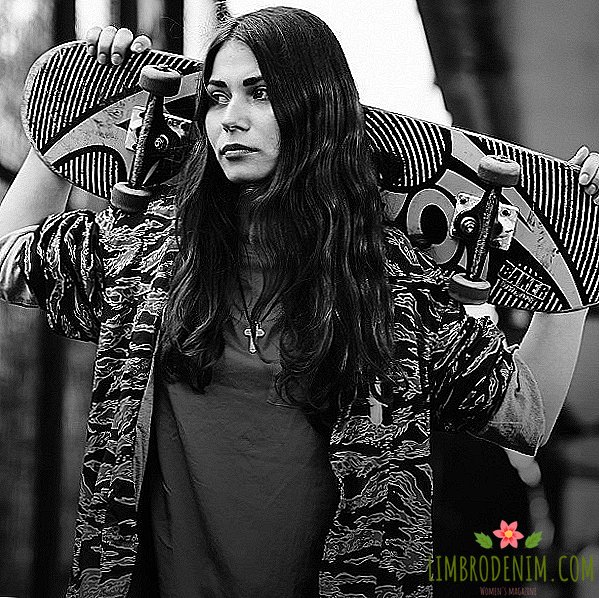Why the fashion market does not take into account people with disabilities
More than a billion people in the worldthat is, 15% of the population, according to WHO, live with any form of disability, and almost 200 million of them are experiencing serious difficulties day after day. It would seem that all these people simply can not be taken into account, but almost all vital areas are inaccessible to them. The fashion industry is one of them: it almost does not see people with amputations, syndromes, paralysis, and other forms of disability; they are practically absent neither in photo shoots, nor in advertising campaigns of brands, nor on podiums, as if such a category of consumers does not exist. Fashion brands do not sew clothes on them and do not even make single capsules. In fact, it turns out that there is no fashionable choice for people with disabilities. We understand why this is happening and where people with health features take clothes.

Columnist of The Guardian, Francis Ryan, moves in a wheelchair. Francis admits that she has always loved fashion and has measured a lot of things since her adolescence, however, skirts and dresses turned out to be too long or short for her, and lightning and buttons on regular jeans always hit the waist. The American journalist Kia Brown is diagnosed with cerebral palsy - she says that it is extremely difficult for her to put things on her own over her head, fasten buttons and zippers. Journalist Evgenia Voskoboinikova moves in a wheelchair and says she would never have bought a full skirt for herself, because she can wind on the wheel, and put on skinny jeans without lifting from her seat is an impossible task.
The question of choosing clothes that would be comfortable, functional, and safe is an edge not only for these girls, but for many people with disabilities around the world. For someone to go to a regular store is no easy task: for example, in 2014, a study of 30,000 retail stores and restaurants was conducted in the UK, which showed that less than a third of them have accessible locker rooms, and 20% do not have ramps - experts called the results are shocking. After three years, the study was repeated, and the changes were minimal: 60% of the stores out of almost 1,300 were not intended to be visited by people with disabilities. "I love mass markets for strict adherence to international standards. Many do not notice, but in any such department there is an elevator, there will definitely be a ramp somewhere. In the fitting rooms there is a large booth. I, as a buyer with features, are attracted. I will buy anything in a store where there are no comfortable conditions, "says Voskoboinikova.
Moreover, most brands can hardly boast of special lines for people of different disability groups. Anna Chernykh, curator of the British Design School of Apparel Design, tells us what needs to be taken into account when creating special clothes: “People with cerebral palsy have very sharp spastic movements that they cannot control. Some of the details in their clothes should be made of extremely durable materials. Many Buttons are useless, even if the person does not dress independently. Wheelchairs usually get very dirty areas on the sleeves and pants, so the fabric must be such that it can be easily wiped. "
But the main thing is that standard sizes presented in stores are usually not suitable for people with disabilities. Each type of disability has its own characteristics: people with Down syndrome are distinguished by sloping shoulders and a wider neck than in a person without a disability; those who move in a wheelchair tend to have thinner legs, but the chest and arm muscles can grow. According to Chernykh, no large-scale anthropometric studies were conducted anywhere in the world that would allow the development of a special dimensional grid for such consumers. But even if you collect a list of all the features, it remains unclear how to create the widest possible, but universal gradation of sizes.
Founder of the Cur8able style project for people with disabilities, Stephanie Thomas points out that brands will not create special clothes until they consider people with disabilities as regular customers. By the way, in the UK there is the concept of "purple pound" - it is the solvency of people with disabilities, which is estimated today at 249 billion pounds. But these numbers are difficult to transfer to countries with minimal social and financial support for disability.
In Russia, people with disabilities, according to the latest data, 12.1 million people. As follows from the documents of the Federal State Statistics Service of Russia, the average pension for one adult with a disability is 13.3 thousand rubles. Additional payments from the federal and regional budgets are also expected - on average between one and five thousand rubles. If a person with a disability is able to work (there are about 1.6 million of them in Russia), he is deprived of the right to these payments, because his average income is 27.5 thousand rubles. At the same time, people with disabilities in Russia are very limited in employment opportunities. It is unlikely that companies will assess the solvency of Russians with disabilities as quite promising: in 2014, 43.9% of households consisting only of people with disabilities stated that they only have enough income for food, but it is already difficult to buy clothes and pay for utility services .

Valentina Volkova, a leading researcher at the G. A. Albrecht Scientific Center for the Rehabilitation of Disabled Persons in St. Petersburg, has developed special clothes for people with hand amputations, thanks to which they can use the help of outsiders if they need to leave the bathroom. Her costumes and skirts do not outwardly differ from ordinary clothes and do not contain complex internal structures - only elastic fabrics, straps and weights, thanks to which the moving parts release the desired body area. Volkova ensured that her clothes were given out to people with a pair amputation free of charge: she was included in the list of technical means of rehabilitation (TSR), so that people with disabilities can apply for the Social Insurance Fund. In addition, she developed a distant technology that allows you to take accurate measurements at the place of residence. Obtained using a special measuring device, they are highly accurate, even small errors are determined. Then the parameters were sent to the St. Petersburg plant for development. Volkova is sure that centers with measuring devices and sewing shops need to be opened throughout the country, because developing standard dimensions for people with disabilities is almost impossible, but such parametric systems will help solve the problem.
At the same time, Russian enthusiasts complain that access to government tenders is mainly obtained by ordinary sewing enterprises, who have no idea what clothes are for people with disabilities. “The winners of such a tender once asked our center if we could make clothes at their own price,” says Volkova. “Models that participate in our shows will not buy adaptive clothing that exists in Russia,” adds the founder of the Bezgraniz Couture project, Yanina Urusova.
Experts believe that those few enterprises that sew clothes for people with disabilities do not take into account either fashion trends or the fact that it should help socialization. Minimal attention is paid to visual design, so clothes look more like medical uniforms. If a person with a disability wants to pick something up for work, walking, visiting a theater or an exhibition, he is trapped: you have to choose between “special” clothes and those that are sold in regular stores, and finding a comfortable one is worth a lot of effort.
Clothing for people with disabilities is bad all over the world, but it would be wrong to say that there are no projects dedicated to the production of clothing for them. For example, in the British Higher School of Design, a two-month module on designing clothing for people with different types of disabilities is taught: Cerebral palsy, Down syndrome, amputations, paralysis. Students conduct two types of research: they personally learn patterns of clothing preferences and the inconvenience associated with it, and then observe how they move and interact with their own things in everyday life.
The Open Style Lab, founded by the Parsons design school, works in a similar way: in addition to designers, engineers and professional therapists are involved in its work. By the way, one of the graduates of the New York School of Design, Lucy Jones, designs clothes for people who move in wheelchairs, and believes that adaptive design opens up more possibilities for finding design solutions. It is necessary to take into account what the length of the leg should be, how much fabric to use so that it does not overtighten the legs at the crotch, and what size to make the sleeves so that they do not press the shoulders and the elbows are not too large. "There is actually no clothing market for people with disabilities. It seems to me that it is always very difficult to be the first, but one student will not solve this problem. Only some large company like Zara and H & M will be able to make special clothes really affordable world product," Black considers .
Tommy Hilfiger, which launched a collection for children with disabilities in 2016 and a line for adults in a year, was one of the most notable fashion brands that consistently addresses the issue of adaptive clothing. New consumers are involved in advertising campaigns: in the spring of 2018, for example, they were Paralympic gold medalist Jeremy Campbell, blogger Mama Cax, paraplegic (that is, with limb paralysis) dancer Chelsea Hill and 18-year-old chef Jeremiah Josie with autism.

Tommy Hilfiger found a universal way to make any clothes more functional, adding magnetic clasps to it. For example, denim jackets from the adaptive collection do not differ in appearance from ordinary ones, however, magnetic buttons are sewn on the wrong side, which do not need to be threaded through loops. On Tommy Hilfiger trousers and jeans, magnets are sewn on the sides so that you can easily get to the prosthesis; dresses are equipped with zippers on the shoulders so that you do not have to shoot a narrow thing over your head.
In the fashion industry (as in the cinema), the image of a person with a disability still often emerges as an object of stylization, and not a reason to pay attention to the people themselves, as if stripped from the consumption system. In 2015, the world public angered the December-January cover of Interview magazine, on which Kylie Jenner appeared in a latex suit, sitting in a wheelchair. The publication defended itself against accusations in eimeme, stating that it wanted only to show how the media objectified and used the image of a girl for their own purposes.
At the same time, a respectful perspective makes it possible to notice that people with disabilities are interested in fashion, pop culture, lead pages in social networks and generally want to occupy a place in society along with the rest. 17-year-old transgender model Aaron Philip actively leads Twitter and instagram: shares the news of his career, his shootings and selfies. Aaron was diagnosed with quadriplegia - paralysis of four limbs - but this does not stop her from working with prestigious agencies (she recently joined Elite Model Management), filming for ASOS, Paper Magazine and Them. She says that she is proud to be herself and wants to be a muse for others: “I want to destroy the negative stigma that surrounds a community of people like me. My opinion will matter as long as I feel beautiful and confident.”
Recently, people with disabilities began to appear on the catwalks: it suffices to recall the autumn-winter show Chromat 2016, in which the model Loren Vasser took part, having lost a leg as a result of toxic shock syndrome; or the Sports Illustrated Swimsuit - 2018, during which Paralympic snowboarding champion Brenna Hukabi walked on the catwalk with a prosthetic leg. Prior to the same Hukabi participated in photography in a bikini for a sports magazine. People with disabilities appeared in the advertising campaigns of Premiata, Aerie and Beauty and Pin-Ups. There are examples in Russia - to take at least numerous shows of Bezgraniz Couture, in which models with cerebral palsy, amputations, Down syndrome and others are involved.
The situation in the beauty industry is changing, albeit slowly: ASOS recently released a jumpsuit for people with disabilities in collaboration with journalist and paralympic Chloe Ball Hopkins. But while designers act alone, and inclusive advertising campaigns are rare, people with disabilities continue to be on the periphery of fashion. And this is not only unfair, but also very short-sighted. Even if individual adaptive projects today seem to someone opportunistic marketing, this is the case when it is fully justified.
Photo: Aerie, Lucy Jones, Tommy Hilfiger





